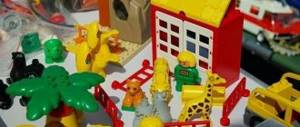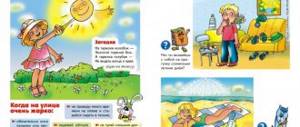Parents' meeting "Games and toys in a child's life."
Municipal state preschool educational institution
Yushinsky kindergarten
Parent meeting “Games and toys in the life of a preschooler”
Completed by: teacher Murzova L.L.
Topic: “Game and toy in the life of a preschooler”
Tasks:
– discuss with parents the problem of the importance of games and modern toys on the mental development of a preschool child;
– show the possibility of play for the development of a child’s intellectual and cognitive activity;
– show the advantages and disadvantages of modern toys;
– stimulate parents’ interest in using the possibilities of gaming activities to communicate with their own child.
Form:
consultation of parents with elements of game training.
Preparatory work:
decoration of the hall.
Elements of the hall design: a poster with the slogan “Let’s extend the happy moment of childhood for our children,” questions for discussion: 1. What role do games and toys play in a child’s life? 2. How important is it for the intellectual and emotional development of a child? 3. Can a toy help a child overcome difficulties communicating with peers? (The questions are written on the poster).
Progress of the meeting
I. Introductory speech by the teacher.
We suggest discussing the following questions:
(The questions are written on the poster).
"Let's play!" - how often do we hear this request from children. And what great joy they experience when we agree. We can be sick or a salesman, a student or a clumsy bear. Usually, when playing with a child, we follow his desire: he himself explains to us what to do. And we, if we have decided to please him, obediently fulfill all his demands.
However, play is not only pleasure and joy for a child, which in itself is very important. In play, the child consolidates the skills he has recently mastered and develops the most important aspects of his psyche. Children feel independent in the game - they communicate with peers at will, realize and deepen their knowledge and skills. While playing, children learn about the world around them, study colors, shapes, properties of material and space, get acquainted with plants, animals, adapt to the diversity of human relationships, etc.
In play, a child reveals his capabilities that are not yet realized in everyday life. It's like looking into the future. In play, a child is stronger, kinder, more resilient, and smarter than in many other situations. And this is natural.
The child must correlate his desires with the desires of other children, otherwise he simply will not be accepted into the game. He can be capricious with his parents and teachers, but not with his partners in the game. The game develops the child’s communication skills; he must learn to establish certain relationships with peers. By accepting this or that role, the child learns the norms of behavior necessary to fulfill this role, and does not simply behave as he wants at the moment. He should be gentle and caring as a parent, kind and attentive as a doctor, polite and careful as a salesman.
The game shapes cognitive abilities, speech, and arbitrariness of behavior. Sometimes it is difficult for a child to control himself, especially his movements. In this case, it is enough to simply tell the clumsy child that now he will be a bunny and must jump so that the fox does not hear him, and all his movements will become precise.
The game rapidly develops the child’s imagination: he builds a train out of chairs, and a garage out of cubes. The child constantly improvises in the game. Tries to involve everyone and everything around him. It’s good when an adult helps to come up with stories, and most importantly, directly participates in the game. By doing this, he not only brings joy to the child, but helps him in his development.
Children, watching adults, strive to imitate them in everything, to live with them on equal terms, reproducing in play what is close and interesting to them (the actions of people in everyday life, work processes, people’s relationships with each other, their recreation, entertainment, etc.). d.). In these games, the theme, content, and sequence of events displayed are important (the driver drives the car, the pilot drives the plane, the mother teaches her daughter, and not vice versa). Such games are called creative, role-playing games. They are inherent in a child after 3-4 years.
Questions for parents.
1. What significance, in your opinion, do the roles that a child takes on have in the moral development of a person?
2. What do you think is the educational value of games?
Educator.
In play, a child acquires new knowledge and refines existing knowledge, activates his vocabulary, develops curiosity, inquisitiveness, as well as moral qualities: will, courage, endurance, and the ability to yield. The beginnings of collectivism are formed in him. In play, a child depicts what he has seen and experienced; he masters the experience of human activity. The game develops an attitude towards people and life; a positive attitude in games helps to maintain a cheerful mood.
In children aged 3-4 years, the basis of the game is the reproduction of relationships among themselves. The world is opening up to children more and more fully. They already see that the driver not only turns the steering wheel, but also enters into certain relationships with the passengers, that the doctor does not just give an injection to the patient, but also communicates with him. The central point in the games of preschoolers is the relationship between adults and the peculiarities of their communication.
But in order to reproduce these relationships, it is necessary to maintain a certain playing role. That is, to fulfill the responsibilities that each role imposes and to exercise the rights that are given by it. The doctor must be polite and attentive to patients and follow the necessary sequence of actions during treatment. At the same time, he has the right to use toys - attributes that he has. The patient is obliged to follow the doctor’s instructions, but at the same time has the right to complain about a variety of diseases and demand new medications.
In order for the roles to be more “expanded,” preschoolers move from individual actions with toys (feeding, dressing, putting them to bed) to reproducing a whole chain of actions. Gradually the child begins to fulfill the role he has assumed.
An example of a role-playing game organized by developing a chain of actions
Game content:
Together with the baby, cook lunch for the doll. Feed her, then wash and put away the dishes together. Then, undress her and put her to bed. Then you can do chores around the house: wash dirty things, wipe off dust, etc.
In this game we see the sequence of game actions and this is what takes it to a higher level.
Later, kids learn to act out the plots of fairy tales and films themselves, and create scripts for games themselves. The development of the plots of children's games is largely determined by the adult, who introduces the child to different areas of life, enriches and develops his play activities, and teaches him almost everything.
Our responsibility is to observe the child, how he plays on the street, with his peers, and whether he knows how to negotiate with children about fulfilling his role. Help him with this. But do it quietly, naturally. After all, it is collective play that develops a child’s ability to establish relationships with peers. If a child has difficulties, an adult should help him choose a plot, explain how best to distribute roles, and, of course, become a playing partner. By helping the child improvise as the game progresses, the adult develops the child’s creative imagination and the ability to quickly rebuild relationships with partners.
Questions for parents.
1. What, in your opinion, is the role of play in a child’s development?
2. Do you think a child learns while playing?
(The teacher invites those who wish to speak, after which he summarizes the answers.)
Educator.
In the game the child learns:
Emotionally get used to, “grow into” the complex social world of adults.
Experience the life situations of other people as your own, understand the meaning of their actions and actions.
Realize your real place among other people.
Respect yourself and believe in yourself. When solving game problems, children show maximum competence; they act confidently, without asking questions of an adult or asking his permission. The game is the arena of children's successes and achievements. The task of adults is to strengthen the child’s self-confidence by showing a positive attitude towards his play activities.
Rely on one's own strength when faced with a problem: play provides children with the opportunity to set and solve their own problems. Children who have extensive play practice cope more easily with real life problems than those who play little.
Freely express your feelings. A child living under the constant vigilant control of adults begins to behave unnaturally. He is not brave and decisive enough to reveal his true feelings, which is why his behavior becomes constrained. Barriers to communication arise. Therefore, adults should have a positive attitude towards his genuine emotions and themselves demonstrate the naturalness and purity of the relationship.
Experience your anger, envy, anxiety and worry. In children's free games, fear, aggression and tension find a way out and weaken, which greatly facilitates real relationships between children.
II. Many of us have forever retained the toys of our childhood in our memories and in real life. Broken, with ears and legs torn off, they have retained their charm for us, they smell of our childhood, the unique joy of getting to know the world. In many families, parents' toys have become children's toys. Parents tell their children the stories of how their toys came into their lives, and share memories of childhood games and fun.
Introduction by parents on the topic of the meeting.
In turn, all parents express their opinions, share with each other their experience in developing a culture of child play with toys, and pass the ball around.
– Thanks for the discussion. In the preschool period, play is the main source of cognition and development. A toy for a child, on the one hand, is a means of self-expression, on the other, a certain ideal, an image that is embedded in the subconscious. Naturally, each age category of children has their own toys.
III. Speech on the topic “The role of toys in the life of a child 2-4 years old.”
First, let's talk about what types of toys there are, what they are needed for, and what each of them can provide for development. There are different types of toys for preschool children.
1. Plot, or
figurative, toys - dolls, animal figurines, furniture, dishes, household items.
The central place is given to the doll. While playing, the child seems to animate the doll, talking to it, trusting it with his secrets and joys, and showing care for it. This group of toys also includes fairy-tale characters. Figurative toys also include those that depict animals and pets. Children feed them, bathe them, put them to bed, treat them, go for walks with them
2. Technical toys.
These toys are increasingly becoming part of life. These include: transport, construction kits, all kinds of technical units. Particularly popular among children are a variety of Lego construction sets that develop fine motor skills, spatial orientation, thinking, and creativity.
3. Fun toys.
These are funny figures of animals, animals, people, for example a bunny playing a drum, or a cook preparing scrambled eggs. They are based on movement, surprise, unexpectedness. Their purpose is to amuse children, cause laughter, empathy, joy, and cultivate a sense of humor.
4. Masquerade and Christmas tree toys.
They are associated with New Year celebrations. They resemble in some way this or that character (tail, beak, ears), but this is enough for children to play and live in the character.
5. Sports and motor toys.
This is a special type of toy that helps increase children’s motor activity, develop coordination of movements, and spatial orientation.
6. Theater toys
.
These toys are figurative in content, but have a special purpose - they serve the purposes of aesthetic education, speech development, and imagination. These include, for example, Parsley and bibabo dolls.
7. Musical toys.
These are rattles, bells, bells, pipes, toys representing a piano, balalaikas and other musical instruments.
8. Educational toys
.
These toys have a special place. With the help of didactic games, children get acquainted with color, shape, size, etc. These include multi-colored inserts, nesting dolls, mosaics, puzzles, lotto, etc. These toys instill in children concentration, perseverance, dedication, the ability to complete a task, and also contribute to the development of fine motor skills.
9. Construction toys
.
They consist of geometric bodies.
Among all the above toys, there are large ones, such as scooters, children's pedal cars, tractors, etc. Sitting at the table, a child will most likely want to play with small, stable toys, but small toys are not suitable for the street.
Question for parents.
Have you ever encountered the fact that a child has different toys, but does not play with them?
(Parents' opinion)
Educator.
Sometimes adults get upset, even angry at the child for not using the toys, not suspecting that he simply does not know how to play with all this. The child is told: “Play!” He takes the toys and, with a bored face, puts the astronaut on a zebra and the Malvina doll on a rhinoceros, then he turns on the motorcyclist and watches him spin around the floor for a long time. Toys themselves will not mean anything to a child if he does not know how and what to play with them. We advise you to play with toys with your child, prompting and showing actions with them.
The toy must meet several requirements: be aesthetically pleasing and must be appropriate for your child’s age and evoke a desire to communicate with her. The game process should evoke positive emotions in the child. You should always pay attention to what material the toy is made of and the quality of workmanship. Never forget that a toy should not only be beautiful, bright and attractive, but first of all, safe. Toys for very young children should not have small parts or sharp edges. After all, the first thing a little tracker will do when he picks up a toy is pull it into his mouth - it’s important to always remember this.
In the second or third years of life, an adult becomes a model of objective actions - toys that offer action are needed (spatulas, rakes, doll utensils). The child begins to learn the purpose of objects; a toy representation of real life will help the child get comfortable in a team.
In addition to ready-made toys, from the age of 2-3, boxes, scraps of fabric, and sticks appear in a child’s everyday life - rubbish from the point of view of adults, but for a child these are very important things that are material for creativity and the development of imagination.
There should be a designated place in the house for games and storage of toys. The child must know where each toy is. Sometimes you need to check whether the child is playing with all the toys; if some have not been involved in the game for a long time, then they need to be hidden for a while. The child must be taught to clean his corner himself. And the most important thing is that a child must be taught to play. And the role of teachers lies with you, parents!
Summarizing.
Educator:
– I think that each of us received a lot of food for thought and good recommendations on the issue of interest. And in parting, I would like to know what our meeting today gave each of you, what new and useful things you learned today, what is worth thinking about. (Parents pass the ball around and express their opinion).
- Let's put a happy ending at the end of our meeting. Now I will tell you small phrases, if you agree with them, perform the appropriate movements. If you don't agree, don't do anything.
– If you think that emotions are not so important when playing with a child, touch the tip of the nose.
– If you believe that a toy is a carrier of information for a child, like a newspaper or the Internet for an adult, stomp your feet.
– If you believe that adults should play games with children, smile.
– If you think that with the help of games, a child’s learning and socialization is more effective, and upbringing is more enjoyable, nod your head.
– If you think that a toy should not only be a tool for play, but also create conditions for its development, wave your hand.
– If you believe that a toy can program a child’s behavior and influence him both positively and negatively, clap your hands.
– Thank you everyone for your active work!




